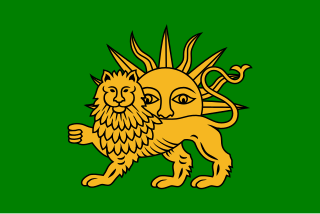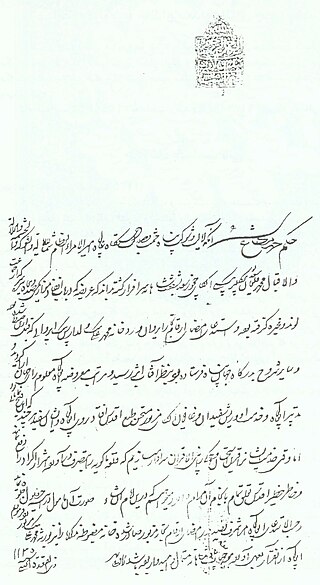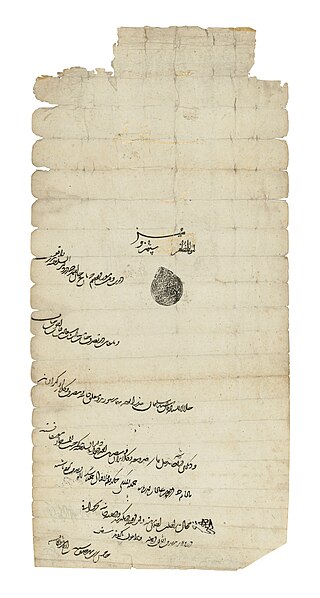
The Safavid dynasty was one of Iran's most significant ruling dynasties reigning from 1501 to 1736. Their rule is often considered the beginning of modern Iranian history, as well as one of the gunpowder empires. The Safavid Shāh Ismā'īl I established the Twelver denomination of Shīʿa Islam as the official religion of the Persian Empire, marking one of the most important turning points in the history of Islam. The Safavid dynasty had its origin in the Safavid order of Sufism, which was established in the city of Ardabil in the Iranian Azerbaijan region. It was an Iranian dynasty of Kurdish origin, but during their rule they intermarried with Turkoman, Georgian, Circassian, and Pontic Greek dignitaries, nevertheless, for practical purposes, they were Turkic-speaking and Turkified. From their base in Ardabil, the Safavids established control over parts of Greater Iran and reasserted the Iranian identity of the region, thus becoming the first native dynasty since the Sasanian Empire to establish a national state officially known as Iran.

Abbas I, commonly known as Abbas the Great, was the fifth shah of Safavid Iran from 1588 to 1629. The third son of Shah Mohammad Khodabanda, he is generally considered one of the greatest rulers of Iranian history and the Safavid dynasty.

Tahmasp I was the second shah of Safavid Iran from 1524 until his death in 1576. He was the eldest son of Ismail I and his principal consort, Tajlu Khanum. Ascending the throne after the death of his father on 23 May 1524, the first years of Tahmasp's reign were marked by civil wars between the Qizilbash leaders until 1532, when he asserted his authority and began an absolute monarchy. He soon faced a long-lasting war with the Ottoman Empire, which was divided into three phases. The Ottoman sultan, Suleiman the Magnificent, tried to install his own candidates on the Safavid throne. The war ended with the Peace of Amasya in 1555, with the Ottomans gaining sovereignty over Iraq, much of Kurdistan, and western Georgia. Tahmasp also had conflicts with the Uzbeks of Bukhara over Khorasan, with them repeatedly raiding Herat. In 1528, at the age of fourteen, he defeated the Uzbeks in the Battle of Jam by using artillery.

Ismail I was the founder and first shah of Safavid Iran, ruling from 1501 until his death in 1524. His reign is often considered the beginning of modern Iranian history, as well as one of the gunpowder empires. The rule of Ismail I is one of the most vital in the history of Iran. Before his accession in 1501, Iran, since its conquest by the Arabs eight-and-a-half centuries earlier, had not existed as a unified country under native Iranian rule. Although many Iranian dynasties rose to power amidst this whole period, it was only under the Buyids that a vast part of Iran properly returned to Iranian rule (945–1055).

Taj Al-Din Ebrahim ibn Rushan Amir Al-Kurdi Al-Sanjani , titled Sheikh Zahed Gilani, was an Iranian Grandmaster of the famed Zahediyeh Sufi order at Lahijan. He is also known as Sultân-ûl Khalwatiyya and Tadj’ad-Dīn Ebraheem Zāheed al-Geylānī as well.
Qizilbash or Kizilbash were a diverse array of mainly Turkoman Shia militant groups that flourished in Azerbaijan, Anatolia, the Armenian highlands, the Caucasus, and Kurdistan from the late 15th century onwards, and contributed to the foundation of the Safavid dynasty in early modern Iran.

Ghiyath al-Din Muhammad, commonly known as Khvandamir was a Persian historian who was active in the Timurid, Safavid and Mughal empires. He is principally known for his Persian universal history, the Habib al-siyar, which was regarded by both the Safavids and Mughals as their first official court account.
Dimdim Castle was a Kurdish fortress located on top of Mount Dimdim in West Azerbaijan Province of Iran, just west of Lake Urmia. This fortress was the location of Battle of Dimdim.
Shaykh Ali Khan Zanganeh, was an Iranian statesman of Kurdish origin, who served as the grand vizier of the Safavid king (shah) Suleiman I from 1669 to 1689. Due to his efforts in reforming the declining Iranian economy, he has been called the "Safavid Amir Kabir" in modern historiography.
The office of amir al-umara, variously rendered in English as emir of emirs, prince of princes,chief emir, and commander of commanders, was a senior military position in the 10th-century Abbasid Caliphate, whose holders in the decade after 936 came to supersede the civilian bureaucracy under the vizier and become effective regents, relegating the Abbasid caliphs to a purely ceremonial role. The office then formed the basis for the Buyid control over the Abbasid caliphs and over Iraq until the mid-11th century.

The Kar-Kiya dynasty, also known as the Kiya'ids, was a local Zaydi dynasty which mainly ruled over Biya-pish from the 1370s to 1592.

Beglerbegi was a title generally held by governors of provinces of higher importance in Safavid Iran.
Mir Najm Zargar Gilani, also known as Shaykh Najm al-Din Zargar Rashti, was an Iranian aristocrat of Gilaki origin, who was the second person to serve as the vakil (vicegerent) of the Safavid Empire.

Hossein Beg Laleh Shamlu was a Qizilbash officer of Turkoman origin, who occupied high offices under the Safavid king Ismail I and was the first person to serve as the vakil (vicegerent) of the empire.
The Kujuji family was an Iranian noble-family native to Tabriz in Iran, and was present from the 15th century to the 18th-century. The first known mentioned member of the family is Amir Zakariya, an officer who originally served as vizier of the Aq Qoyunlu federation, but later changed his allegiance to the Safavid king (shah) Ismail I, and was appointed as his vizier by him, thus becoming the first vizier of the Safavid Empire. Zakariya later died in 1512/3.
The Military of Safavid Iran covers the military history of Safavid Iran from 1501 to 1736.
The Khoy Khanate, also known as the Principality of Donboli, was a hereditary Kurdish khanate around Khoy and Salmas in Iran ruled by the Donboli tribe from 1210 until 1799. The khanate has been described as the most powerful khanate in the region during the second half of the 18th century. The official religion of this principality was originally Yezidism, until some rulers eventually converted to Islam. The principality has its origins under the Ayyubid dynasty and was ultimately dissolved in 1799 by Abbas Mirza. During this period, the status of principality oscillated between autonomous and independent.
The Khalifeh family, also known as the Khalifeh sayyids, were a branch of the Marashi dynasty of Mazandaran, whose ancestor, Amir Nezam al-Din, had settled in the Golbar quarter of Isfahan in the 15th century.

Abdollah Khan Ustajlu was a high-ranking Iranian dignitary of Turkoman origin, who served during the reign of king (shah) Tahmasp I (1524-1576). He successively held the posts of amir al-omarāʾ (commander-in-chief) and divanbegi, before becoming the governor of Shirvan from 1549 until 1565 or 1566.

The Erivan Province, also known as Chokhur-e Sa'd, was a province of Safavid Iran, centered on the territory of the present-day Armenia. Erivan (Yerevan) was the provincial capital and the seat of the Safavid governors.